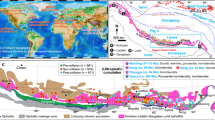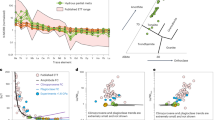Abstract
Continental crust is buoyant compared with its oceanic counterpart and resists subduction into the mantle. When two continents collide, the mass balance for the continental crust is therefore assumed to be maintained. Here we use estimates of pre-collisional crustal thickness and convergence history derived from plate kinematic models to calculate the crustal mass balance in the India–Asia collisional system. Using the current best estimates for the timing of the diachronous onset of collision between India and Eurasia, we find that about 50% of the pre-collisional continental crustal mass cannot be accounted for in the crustal reservoir preserved at Earth’s surface today—represented by the mass preserved in the thickened crust that makes up the Himalaya, Tibet and much of adjacent Asia, as well as southeast Asian tectonic escape and exported eroded sediments. This implies large-scale subduction of continental crust during the collision, with a mass equivalent to about 15% of the total oceanic crustal subduction flux since 56 million years ago. We suggest that similar contamination of the mantle by direct input of radiogenic continental crustal materials during past continent–continent collisions is reflected in some ocean crust and ocean island basalt geochemistry. The subduction of continental crust may therefore contribute significantly to the evolution of mantle geochemistry.
This is a preview of subscription content, access via your institution
Access options
Subscribe to this journal
Receive 12 print issues and online access
$259.00 per year
only $21.58 per issue
Buy this article
- Purchase on Springer Link
- Instant access to full article PDF
Prices may be subject to local taxes which are calculated during checkout



Similar content being viewed by others
Change history
27 March 2017
The authors omitted to cite a paper5 that used a crustal mass-balance approach, but alternative constraints on paleogeography and pre-collisional crustal geometries, to argue that about 40 to 50% of Indian crust is missing from the present-day crustal reservoir of the Himalayan–Tibetan system and may have been recycled into the mantle. Given limited constraints on the uncertainty of this estimate, the authors chose to focus their comparison on the later work of Yakovlev and Clark (2014). Nevertheless, the authors have decided the work of Replumaz and colleagues merits citation. References 5. Replumaz, A., Negredo, A.M., Guillot, S., van der Beek, P. & Villaseñor, A. Crustal mass budget and recycling during the India/Asia collision. Tectonophysics 492, 99–107 (2010).
References
Dewey, J. F. & Bird, J. M. Mountain belts and the new global tectonics. J. Geophys. Res. 75, 2625–2647 (1970).
McKenzie, D. P. Speculations on the consequences and causes of plate motions. Geophys. J. R. Astron. Soc. 18, 1–32 (1969).
Richter, F., Rowley, D. & DePaolo, D. Sr isotope evolution of seawater: the role of tectonics. Earth Planet. Sci. Lett. 109, 11–23 (1992).
van Hinsbergen, D. J. J. et al. Restoration of Cenozoic deformation in Asia and the size of Greater India. Tectonics 30, TC5003 (2011).
Replumaz, A. Guillot, A. M. van der Beek, P. & Villaseñor, A. Crustal mass budget and recycling during the India/Asia collision. Tectonophysics 492, 99–107 (2010).
Yakovlev, P. & Clark, M. Conservation and redistribution of crust during the Indo-Asian collision. Tectonics 33, 1016–1027 (2014).
England, P. & Houseman, G. Finite strain calculations of continental deformation: 2. Comparison with the India–Asia collision zone. J. Geophys. Res. 91, 3664–3676 (1986).
Clift, P. D. Controls on the erosion of Cenozoic Asia and the flux of clastic sediment to the ocean. Earth Planet. Sci. Lett. 241, 571–580 (2006).
Métivier, F., Gaudemer, Y., Tapponnier, P. & Klein, M. Mass accumulation rates in Asia during the Cenozoic. Geophys. J. Int. 137, 280–318 (2002).
Tapponnier, P., Peltzer, G., Le Dain, A. Y., Armijo, R. & Cobbold, P. Propagating extrusion tectonics in Asia: new insights from simple experiments with plasticine. Geology 10, 611–616 (1982).
Gaetani, M. & Garzanti, E. Multicyclic history of the northern India continental margin (northwestern Himalaya) (1). Am. Assoc. Petrol. Geol. Bull. 75, 1427–1446 (1991).
Green, O. R., Searle, M. P., Corfield, R. I. & Corfield, R. M. Cretaceous-Tertiary carbonate platform evolution and the age of the India–Asia collision along the Ladakh Himalaya (northwest India). J. Geol. 116, 331–353 (2008).
Roddaz, M. et al. Provenance of Cenozoic sedimentary rocks from the Sulaiman fold and thrust belt, Pakistan: implications for the palaeogeography of the Indus drainage system. J. Geol. Soc. Lond. 168, 499–516 (2011).
Wilke, F. D. H. et al. The multistage exhumation history of the Kaghan Valley UHP series, NW Himalaya, Pakistan from U-Pb and 40Ar/39Ar ages. Eur. J. Mineral. 22, 703–719 (2010).
Leech, M., Singh, S., Jain, A., Klemperer, S. & Manickavasagam, R. The onset of India–Asia continental collision: early, steep subduction required by the timing of UHP metamorphism in the western Himalaya. Earth Planet. Sci. Lett. 234, 83–97 (2005).
St-Onge, M. R., Rayner, N., Palin, R. M., Searle, M. P. & Waters, D. J. Integrated pressure-temperature-time constraints for the Tso Morari dome (northwest India): implications for the burial and exhumation path of UHP units in the western Himalaya. J. Metamorph. Geol. 31, 469–504 (2013).
Bouilhol, P., Jagoutz, O., Hanchar, J. M. & Dudas, F. O. Dating the India–Eurasia collision through arc magmatic records. Earth Planet. Sci. Lett. 366, 163–175 (2013).
DeCelles, P., Kapp, P., Gehrels, G. & Ding, L. Paleocene-Eocene foreland basin evolution in the Himalaya of southern Tibet and Nepal: implications for the age of initial India–Asia collision. Tectonics 33, 824–849 (2014).
Rowley, D. Age of initiation of collision between India and Asia: a review of stratigraphic data. Earth Planet. Sci. Lett. 145, 1–13 (1996).
Aikman, A. B., Harrison, T. M. & Lin, D. Evidence for early (>44 Ma) Himalayan crustal thickening, Tethyan Himalaya, southeastern Tibet. Earth Planet. Sci. Lett. 274, 14–23 (2008).
Argand, E. Proc. XIIIth Int. Geol. Congr. vol. 1, pt. 5, 181–372 (Hafner Press, 1924).
van Hinsbergen, D. J. J. et al. Greater India Basin hypothesis and a two-stage Cenozoic collision between India and Asia. Proc. Natl Acad. Sci. USA 109, 7659–7664 (2012).
Orme, D. A., Carrapa, B. & Kapp, P. Sedimentology, provenance and geochronology of the upper Cretaceous-lower Eocene western Xigaze forearc basin, southern Tibet. Basin Res. 27, 1–25 (2014).
Laske, G., Masters, G., Ma, Z. & Pasyanos, M. Update on CRUST1.0 - A 1-degree global model of Earth’s crust. European Geosciences Union (Geophysical Research Abstracts, 2013).
Zhu, B., Kidd, W. S. F., Rowley, D. B., Currie, B. S. & Shafique, N. Age of initiation of the India–Asia collision in the East-Central Himalaya. J. Geol. 113, 265–285 (2005).
Ding, L. et al. The Andean-type Gangdese Mountains: paleoelevation record from the Paleocene–Eocene Linzhou basin. Earth Planet. Sci. Lett. 392, 250–264 (2014).
Ingalls, M., Rowley, D. & Colman, A. Paleocene-Eocene Lhasaplano paleoaltimetry: implications for mass balance in the India–Asia collision. Goldschmidt Conf. (Cambridge Publications, 2015).
Zhang, K. J. Cretaceous palaeogeography of Tibet and adjacent areas (China): tectonic implications. Cretac. Res. 21, 23–33 (2000).
Leloup, P. H. et al. The Ailao Shan-Red River shear zone (Yunnan, China), tertiary transform boundary of Indochina. Tectonophysics 251, 3–84 (1995).
Li, C., van der Hilst, R. D., Meltzer, A. S. & Engdahl, E. R. Subduction of the Indian lithosphere beneath the Tibetan Plateau and Burma. Earth Planet. Sci. Lett. 274, 157–168 (2008).
Nabelek, J. et al. Underplating in the Himalaya–Tibet collision zone revealed by the Hi-CLIMB experiment. Science 325, 1371–1374 (2009).
Wittlinger, G., Farra, V., Hetenyi, G., Vergne, J. & Nabelek, J. Seismic velocities in southern Tibet lower crust: a receiver function approach for eclogite detection. Geophys. J. Int. 177, 1037–1049 (2009).
Hetenyi, G. et al. Density distribution of the India plate beneath the Tibetan Plateau: geophysical and petrological constraints on the kinetics of lower-crustal eclogitization. Earth Planet. Sci. Lett. 264, 226–244 (2007).
Bollinger, L., Henry, P. & Avouac, J.-P. Mountain building in the Nepal Himalaya: thermal and kinematic model. Earth Planet. Sci. Lett. 244, 58–71 (2006).
Zhang, P.-Z. et al. Continuous deformation of the Tibetan Plateau from global positioning system data. Geology 32, 809–812 (2004).
Hafkenscheid, E., Wortel, M. J. R. & Spakman, W. Subduction history of the Tethyan region derived from seismic tomography and tectonic reconstructions. J. Geophys. Res. 111, B08401 (2006).
van der Voo, R., Spakman, W. & Bijwaard, H. Tethyan subducted slabs under India. Earth Planet. Sci. Lett. 171, 7–20 (1999).
Lee, C. in Treatise on Geochemistry 2nd edn (eds Holland, H. & Turekian, K.) 423–456 (Elsevier, 2014).
Hanan, B. B. et al. Pb and Hf isotope variations along the Southeast Indian Ridge and the dynamic distribution of MORB source domains in the upper mantle. Earth Planet. Sci. Lett. 375, 196–208 (2013).
Hofmann, A. W. in Treatise on Geochemistry 2nd edn (eds Holland, H. & Turekian, K.) 67–101 (Elsevier, 2014).
O’ Brien, P. J. in Orogenic Processes: Quantification and Modelling in the Variscan Belt (eds Franke, W., Haak, V., Oncken, O. & Tanner, D.) 369–386 (Geological Society Special Publications 179, The Geological Society, 2000).
Fritz, H. et al. Orogen styles in the East African Orogen: a review of the Neoproterozoic to Cambrian tectonic evolution. J. Afr. Earth Sci. 86, 65–106 (2013).
Dewey, J. F. & Burke, K. C. A. Tibetan, Variscan, and Precambrian basement reactivation: products of continental collision. J. Geol. 81, 683–692 (1973).
Acknowledgements
We thank P. Yakovlev for generously sharing both crustal thickness and domain polygon boundary with us. Fieldwork was funded by the National Science Foundation Grant EAR no. 0609782 and EAR no. 1111274 awarded to D.B.R. and EAR no. 0609756 awarded to B.C. Supporting geochemical analyses were enabled by NSF EAR no. 0923831 awarded to A.S.C. and D.B.R.
Author information
Authors and Affiliations
Contributions
D.B.R. and M.I. completed mass-balance calculations. M.I., D.B.R., B.C. and A.S.C. contributed to the manuscript.
Corresponding authors
Ethics declarations
Competing interests
The authors declare no competing financial interests.
Supplementary information
Supplementary Information
Supplementary Information (PDF 310 kb)
Supplementary Table 1
Supplementary Information (XLSX 63 kb)
Supplementary Table 2
Supplementary Information (XLSX 51 kb)
Supplementary Table 3
Supplementary Information (XLSX 58 kb)
Rights and permissions
About this article
Cite this article
Ingalls, M., Rowley, D., Currie, B. et al. Large-scale subduction of continental crust implied by India–Asia mass-balance calculation. Nature Geosci 9, 848–853 (2016). https://doi.org/10.1038/ngeo2806
Received:
Accepted:
Published:
Issue Date:
DOI: https://doi.org/10.1038/ngeo2806
This article is cited by
-
Geodynamic models of Indian continental flat slab subduction with implications for the topography of the Himalaya-Tibet region
Scientific Reports (2024)
-
Paleogene India-Eurasia collision constrained by observed plate rotation
Nature Communications (2023)
-
New constraints on Cenozoic subduction between India and Tibet
Nature Communications (2023)
-
Possible South-Dipping Mesozoic Subduction at Southern Tethys Ocean-Constrained from Global Tectonic Reconstructions and Seismic Tomography
Journal of Earth Science (2023)
-
Timing and mechanisms of Tibetan Plateau uplift
Nature Reviews Earth & Environment (2022)



